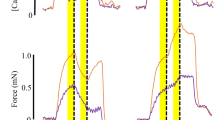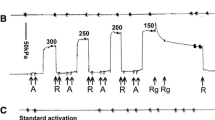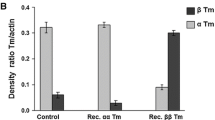Abstract
Increasing concentrations of MgADP− or MgCDP− in the millimolar range cause an increase in the maximum Ca2+-activated tension that a skinned rabbit soleus muscle fiber can develop in the presence of 2 mM MgATP2− or MgCTP2 respectively. In contrast, the maximal Ca2+-activated ATPase activity of the fiber decreases in the presence of MgADP−. As the nucleoside diphosphate (MgADP− or MgCDP−) concentration is increased, the Ca2+ concentration required for half-maximal activation of tension is reduced.MgADP− has a similar effect on the Ca2+ concentration required to half-maximally activate the fiber ATPase. The effects on tension are due to magnesium nucleoside diphosphate and not some other form of nucleoside diphosphate since the effects occur at both low (pMg 4) and control (pMg 3) Mg2+ concentrations. Cooperativity, as judged by the Hill “n” value relating isometric tension and Ca2+, is less in the presence of 5 mM MgADP− as compared to a control (no added MgADP−) “n” value. Increasing concentrations of inorganic phosphate (Pi) in the millimolar range decrease maximum Ca2+-activated tension, and increase the concentration of Ca2+ required to half-maximally activate tension, effects opposite to those of MgADP. These data are consistent with the hypothesis that cooperative interactions between actin and myosin can affect the affinity of troponin for Ca2+.
Similar content being viewed by others
References
Adolfsen R, Moudrianakis EN (1978) Control of complex metal ion equilibria in biochemical reaction systems. J Biol Chem 253:4378–4379
Brandt PW, Cox RN, Kawai M, Robinson T (1982) Regulation of tension of skinned muscle fibers: Effect of cross-bridge kinetics on apparent Ca2+ sensitivity. J Gen Physiol 79:997–1016
Bremel RD, Weber A (1972) Cooperation within actin filament in vertebrate skeletal muscle. Nature (Lond) New Biol 238:97–101
Cassidy PS, Kerrick WGL (1979) Enzymatic preparation of adenosine 5′-O-(3[35S]thiotriphosphate) by thiophosphorylation of adenosine diphosphate. Biochim Biophys Acta 565:209–213
Cassidy PS, Kerrick WGL (1982) Superprecipitation of gizzard actomyosin, and tension in gizzard muscle skinned fibers in the presence of nucleotides other that ATP. Biochim Biophys Acta 705:63–69
Chalovich JM, Eisenberg E (1982) Inhibition of actomyosin ATPase activity by troponin-tropomyosin without blocking the binding of myosin to actin. J Biol Chem 257:2432–2437
Chalovich JM, Chock PB, Eisenberg E (1981) Mechanism of action of troponin-tropomyosin. Inhibition of actomyosin ATPase activity without inhibition of myosin binding to actin. J Biol Chem 256:575–578
Cooke R, Pate E (1985) The effects of ADP and phosphate on the contraction of muscle fibers. Biophys J 48:789–798
Dantzig JA, Hibberd MG, Goldman YE, Trentham DR (1984) ADP slows cross-bridge detachment rate induced by photolysis of caged ATP in rabbit psoas muscle fibers. Biophys J 45:8a
Donaldson SKB, Kerrick WGL (1975) Characterization of the effects of Mg2+ on Ca2+-and Sr2+-activated tension generation of skinned skeletal muscle fibers. J Gen Physiol 66:427–444
Eisenberg E, Hill TL (1985) Muscle contraction and free energy transduction in biological systems. Science 227:999–1006
Fuchs F (1977) Cooperative interactions between calcium-binding sites on glycerinated muscle fibers. The influence of cross-bridge attachment. Biochim Biophys Acta 462:314–322
Green LE, Eisenberg E (1980) Cooperative binding of myosin subfragment-1 to the actin-troponin-tropomyosin complex. Proc Natl Acad Sci USA 77:2616–2620
Hellam DC, Podolsky RJ (1969) Force measurements in skinned muscle fibres. J Physiol 200:807–819
Hibberd MG, Dantzig JA, Trentham DR, Goldman YE(1985a) Phosphate release and force generation in skeletal muscle fibers. Science 228:1317–1319
Hibberd MG, Webb MR, Goldman YE, Trentham DR (1985b) Oxygen exchange between phosphate and water accompanes calcium-regulated ATPase activity of skinned fibers from rabbit skeletal muscle. J Biol Chem 260:3496–3500
Hill AV (1913) The combinations of haemoglobin with oxygen and with carbon monoxide. Biochem J 7:471–480
Hill TL (1983) Two elementary models for the regulation of skeletal muscle contraction by calcium. Biophys J 44:383–396
Hiratsuka T (1984) Affinity labeling of the myosin ATPase with ribose-modified fluorescent nucleotides and vanadate. J Biochem (Tokyo) 96:147–154
Hoar PE, Kerrick WGL (1979) Rabbit diaphragm: two types of fibers determined by calcium/strontium activation and protein content. J Physiol 295:345–352
Kawai M, Guth K (1986) ATP hydrolysis rate and crossbridge kinetics as functions of ionic strength and phosphate ion concentration in chemically skinned rabbit psoas fibers. Biophys J 49:9a
Kerrick WGL, Donaldson SKB (1975) The comparative effects of [Ca2+] and [Mg2+] on tension generation in the fibers of skinned frog skeletal muscle and mechanically disrupted rat ventricular cardiac muscle. Pflügers Arch 385:195–201
Kerrick WGL, Krasner B (1975) Disruption of the sarcolemma of mammalian skeletal muscle fibers by homogenization. J Appl Physiol 39:1052–1055
Lanzetta PA, Alvarez LJ, Reinach PS, Candis OA (1979) An improved assay for nanomole amounts of inorganic phosphate. Anal Biochem 100:95–97
Marston SB, Taylor EW (1980) Comparison of the myosin and actomyosin ATPase mechanisms of the four types of vertebrate muscles. J Mol Biol 139:573–600
Meyer RA, Brown TR, Kushmerick MJ (1985) Phosphorus nuclear magnetic resonance of fast- and slow-twitch muscle. Am J Physiol 248:C279-C287
Pecoraro VL, Hermes JD, Cleland WW (1984) Stability constants of Mg2+ and Cd2+ complexes of adenine nucleotides and thionucleotides and rate constants for formation and dissociation of MgATP and MgADP. Biochemistry 223:5262–5271
Sillen LG, Martell AE (1964)Stability constants of metal-ion complexes. The Chemical Society, London. Special publication No. 17
Spector T (1978) Refinement of the Coomassie blue method of protein quantitation. Anal Biochem 85:142–146
Wegner A (1979) Equilibrium of the actin-tropomyosin interaction. J Mol Biol 131:839–853
Author information
Authors and Affiliations
Additional information
A preliminary report of this work was given at the Biophysical Society Meeting, February 1985, W. G. L. Kerrick, P. E. Hoar (1985) Effects of nucleotide diphosphate and inorganic phosphate on tension in skinned soleus and smooth muscle cells. Biophys J 47:296a
Rights and permissions
About this article
Cite this article
Hoar, P.E., Mahoney, C.W., Kerrick, W.G.L. et al. MgADP− increases maximum tension and Ca2+ sensitivity in skinned rabbit soleus fibers. Pflugers Arch. 410, 30–36 (1987). https://doi.org/10.1007/BF00581892
Received:
Accepted:
Issue Date:
DOI: https://doi.org/10.1007/BF00581892




